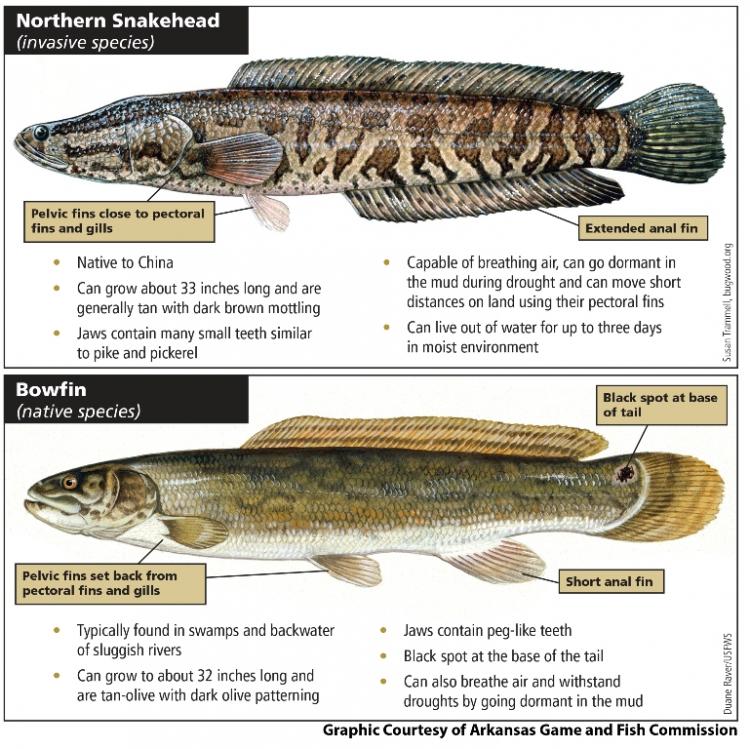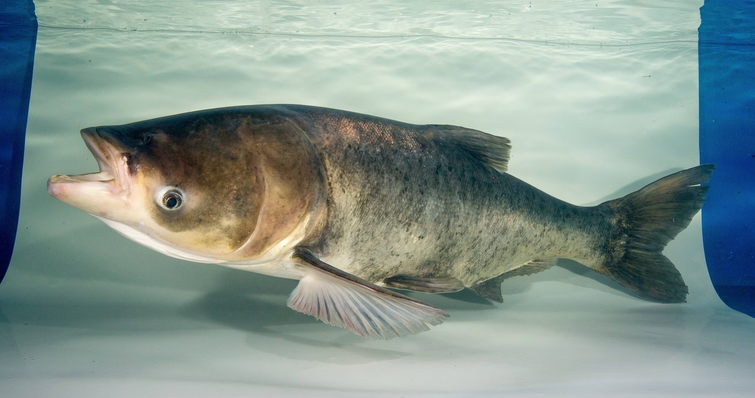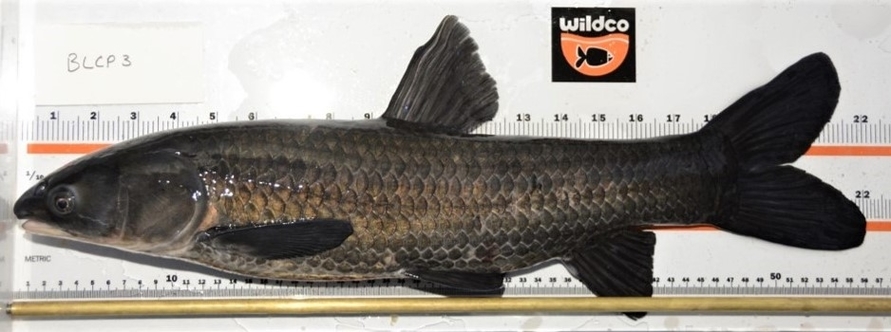Contact
1200 N. University Dr.
Mail Slot 4912
Pine Bluff, AR 71601
Invasive Fish in Arkansas
Invasive species which prosper in a new environment typically are harmful to native species. The Northern Snakehead and Asian Carp are cause for concern in the Mississippi, White, and Arkansas Rivers.
What is the Northern Snakehead?
Northern snakehead fish are an invasive species that have established in several tributaries of the Mississippi, White, and Arkansas Rivers in Eastern Arkansas. Northern snakehead have long cylindrical bodies with a somewhat flattened head and sharp teeth inside the mouth. The body is usually dark tan-brown with darker blotches throughout.
How to identify northern snakehead
Northern snakehead closely resemble native bowfin (aka grinnel) but they can be differentiated by the length of their anal fin and location of their pelvic fins. The anal fin is highly elongated in northern snakehead, including 32 to 38 soft fin rays, compared to the relatively short anal fin of the bowfin with only 9 to 12 soft fin rays. The pelvic fins of northern snakehead are located just behind their pectoral fins, compared to the pelvic fins of bowfin being located farther back on the body in an abdominal position.

Northern Snakehead Characteristics
- Native to China
- Can grow about 33 inches
- Generally tan with dark brown mottling
- Jaws contain many small teeth similar to pike
and pickerel - Capable of breathing air and can survive for
up to three days on land in moist environment - Can withstand drought by going dormant in
mud - Can move short distances on land using
pectoral fins
Bowfin Characteristics
- Native to Arkansas
- Typically found in swamps and backwater
of sluggish rivers - Can grow to about 32 inches
- Tan-olive with dark olive patterning
- Black spot at base of tail
- Jaws contain peg-like teeth
- Can also breathe air
- Can also withstand drought by going
dormant in the mud
Habitat and diet of northern snakehead
Northern snakehead are a hearty species that can persist in many types of habitat but they appear to prefer shallow, stagnant waters with soft, muddy bottoms and aquatic vegetation. They are obligate air-breathers, meaning that they must regularly breathe atmospheric air to survive. Northern snakehead can survive up to four days completely out of the water. They are also known for moving short distances over land, though it is less common in larger adults than juveniles.
Northern snakehead are aggressive predators, likely matching the diet preferences of largemouth bass closely in most situations. The current and potential impact of northern snakehead on local fish communities is currently unknown.
Asian Carps in Arkansas
While Asian carps include grass carp, agencies are usually referring to silver, bighead, and black carp when discussing invasive species in the U.S. Grass carp are frequently stocked in private, and sometimes public, waters as a cost-effective aquatic vegetation control tool, but they are almost always required to be functionally sterile triploids.
Silver and bighead carp have established throughout much of the Mississippi River drainage, including the White and Arkansas Rivers. Black carp have not spread as quickly, but they have been confirmed in the lower White and Mississippi Rivers. Silver carp are deep-bodied and laterally compressed with very small silvery scales. Their eyes are slightly downward facing.
- Silver carp are known to jump above the surface of the water when startled by the sound of boat engines. This behavior and their large size, commonly 40 to 60 pounds as adults, makes them very dangerous for boaters.
- Bighead carp are very similar in body shape and size to silver carp, but with slightly larger heads and dark blotches along their sides.
- Black carp closely resemble grass carp, with large scales and somewhat cylindrical bodies. Black carp are darker in coloration than grass carp and they have molar teeth specialized for crushing mollusks.

Bighead carp are very similar in size and shape to silver carp, but with slightly
larger heads and dark blotches along their sides.
Image courtesy of the U.S. Fish and Wildlife Service.
How to identify Asian carp
Silver carp are deep-bodied and laterally compressed with small silvery scales. Their eyes are slightly downward facing. Silver carp are known to jump above the surface of the water when startled by the sound of boat engines. This behavior and their large size, commonly 40-60 pounds as adults, make them very dangerous for boaters.
Diet of Asian carp
Silver and bighead carp are large filter-feeding planktivorous river fish. Several studies have demonstrated that silver and bighead carp affect zooplankton communities which directly impact native planktivorous fish like gizzard shad and bigmouth buffalo. Zooplankton are a critical food source for small fishes, and larval stages of large fishes, so the impact of silver and bighead carp on fish communities as a whole can be substantial.

Black carp closely resemble grass carp, with large scales and somewhat cylindrical bodies. Black carp are darker in coloration than grass carp and they have molar teeth specialized for crushing mollusks.
Image courtesy of the USGS Columbia Environmental Research Center.
Black carp are large molluscivorous river fish that have the ability to significantly reduce benthic invertebrate abundance in experimental ponds. This is a severe threat to public waters as most native snail and mussel species in North America are already threatened or endangered for one reason or another.
What if I find a Northern Snakehead or an Asian carp?
If you find a northern snakehead, silver, bighead or black carp, kill it immediately and report your encounter to the Arkansas Game and Fish Commission Aquatic Nuisance Species coordinator by email at reportans@agfc.ar.gov.
If you are unsure whether you found an Asian carp or Northern Snakehead, contact the Arkansas Game and Fish Commission for identification assistance (501-223-6300 or 800-354-4263).
Photographs and location details are very helpful in both situations. Reports from the public are critical to help track the spread of nuisance species.
Be sure to report, as it is illegal to have LIVE OR DEAD northern snakehead in your possession, and it is illegal to have LIVE silver, bighead or black carp in your possession.